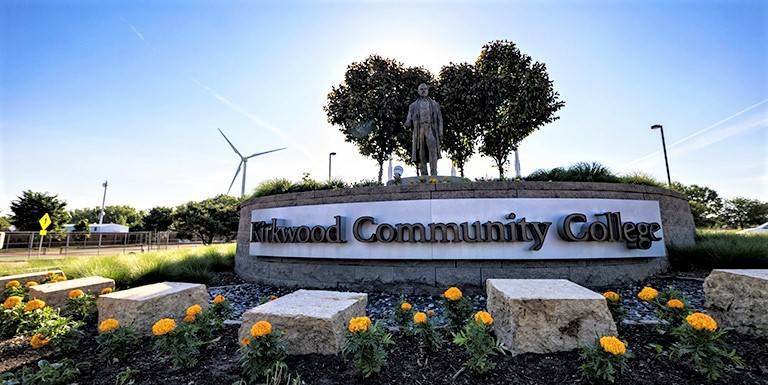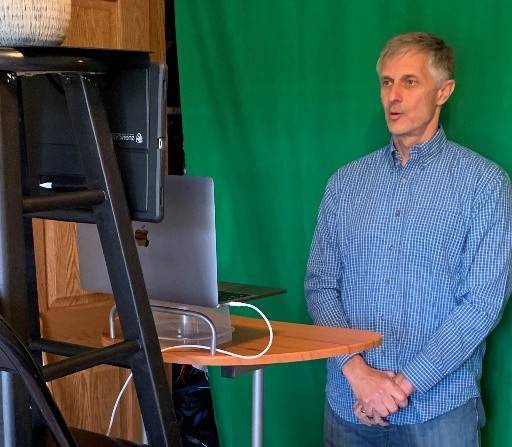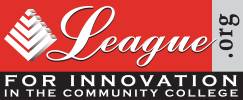Mentoring Mondays
Permanent link for Mentoring Mondays - June 22, 2020 on June 22, 2020
LEADING AN INSTITUTION IN UNPRECEDENTED TIMES
By: Justin Hoehn
June 2020
Volume: 33
Number: 6 Leadership Abstracts
(first photo: At this point in any normal year, the campuses of Kirkwood Community College, like those of colleges across the U.S. and beyond, would be enjoying the relative quiet of another summer term. There would be some campus and classroom activity, of course, but compared to the hustle and bustle of fall and spring, the hallways would have a serene and peaceful quality to them. In many ways, it would seem as if the college itself was resting as it prepared for the grind of another fall semester. But this is 2020—and it is not a normal year.)
If you go to one of Kirkwood’s campuses today, buildings are locked, no students or faculty walk the halls, and classrooms and offices sit empty. Yet, Kirkwood is alive and well—it’s just been transformed. Lectures have been moved from physical spaces to digital classrooms. Financial Aid and Enrollment staff assist students from the comfort (or, some might say, confinement) of their own homes. Campus visits and orientations are performed virtually. While not everything is available as it was at the beginning of the year, students still receive the instruction and services they need.
The Beginning
While the Kirkwood community followed the news about COVID-19, particularly once the World Health Organization (WHO) declared a global health emergency on January 30, the virus seemed mostly contained to far-off parts of the world, despite its rapid spread. However, as the virus began to spread more rapidly around the globe and cases were identified in the U.S., people began to be more concerned.
When it became apparent that COVID-19 would have a profound impact on Kirkwood and the surrounding community, many questions had to be answered if the college was to continue to function. How would students receive instruction? What needed to happen to convert in-person classes to an online format? How would Kirkwood, one of the largest higher education institutions in Iowa, move all of its faculty and staff to a remote working environment? Perhaps most importantly, how would it all happen in a matter of days? Leadership had to act quickly.
The first response from the college started in early February when a small group of staff gathered to discuss a public health-style Stop the Spread flier promoting good hygiene practices and hand washing. While the language was kept generic to apply to all respiratory diseases, including COVID-19, it was primarily developed to address a seemingly aggressive flu strain. As part of this initial effort, Kirkwood's Campus Health webpage was updated with information and tips to help stop the spread of illness. A few sentences were dedicated to COVID-19, but detail was minimal.
With students from all over the world studying at Kirkwood and study abroad programs on the horizon, the Global Learning department began communicating pertinent COVID-19 information to its students through emails and website updates. As the situation progressed, the department continued to keep these students informed with the latest travel advisories, study abroad information, and data from WHO and the Centers for Disease Control and Prevention (CDC).
Increasingly concerned about the alarming news surrounding the virus, Kirkwood President Lori Sundberg called a meeting with select college leadership in late February to discuss the virus, the threat it posed, and CDC recommendations, and to start thinking about contingency plans if the situation devolved to the level where action had to be taken. While no concrete decisions were made at that point, one thing was certain: Communication with the campus community would need to be a large part of any college response. To help alleviate anxiety, a note from President Sundberg addressing the situation was sent to faculty and staff.
“I felt it was important to let everyone know that the college was monitoring the situation and was prepared to act, if necessary,” said Sundberg. She continued,
Even though we had no confirmed cases in Iowa at that point, you could feel a definite rise in the anxiety level around the institution. So, I wanted to ease their minds and let them know that we would do whatever was necessary to help keep our community safe.
The Response
As the calendar flipped to March, contingency planning for various scenarios was well underway. To keep the college community informed, regular communications were sent to students and employees. Topics ranged from travel advisories to restrictions for students in health programs to the need to stay informed. As the spread of the virus continued to pick up speed, so did the number of messages to everyone on campus, especially after the first cases in Iowa were reported in Johnson County—within the college’s service area.
President Sundberg called the Kirkwood Incident Command team together on March 10. The purpose of the team, with representatives from Academic Affairs, Student Services, Information Technologies, Marketing and Communications, and Facilities and Security, was to execute the decisions of college leadership. When the WHO announced the next day that the outbreak had reached pandemic level, the group put a plan in motion to limit potential spread on campus. Lecture classes were moved online after spring break, while labs and hands-on classes remained in a face-to-face format. At the same time, an email address, manned by Student Services staff, was established to answer student questions and concerns. The new blueprint for classroom instruction was to be in place until at least April 10, with the stipulation that the plan could change at any time, based on new data.
As Kirkwood was preparing to implement the new plan just before spring break, President Trump declared a national emergency. This announcement, coupled with the barrage of bad news about COVID-19 over the weekend, prompted the college to announce more stringent measures to help protect the Kirkwood community:
- All face-to-face classes, including labs and hands-on courses, were suspended through April 10.
- Lecture classes were moved online through April 10 rather than March 23.
- Continuing Education classes were suspended through April 10.
- College buildings and locations were closed to everyone except a handful of employees needed to perform essential in-person tasks through April 3.
- All campus-based events were cancelled through April 3.
- All college-related travel was suspended through April 10.
For the college to continue operations and offer classes and services remotely based on this plan, and do it without a hitch, much work needed to be done.
Academic Affairs was tasked with moving all lecture classes to an online format and getting students and faculty prepared. Fortunately, many faculty and staff were already familiar with the video conferencing app Zoom, but those who weren’t needed to be quickly trained. There was also the issue of making sure that students had the ability to attend class online. Working with the IT department, Academic Affairs set up a system for students to request and check out laptops and Internet hotspots. The IT department also set employees up on Kirkwood’s virtual private network and college phone lines, as needed. In addition, IT support was required by Student Services departments—including Academic Advising, Financial Aid, Registration, Veterans Affairs, and Student Life—which would continue to offer services during the shutdown. For example, the student food pantry was more essential than ever, as some of the students and families that relied on its services were losing their jobs. Student Services, therefore, worked with the Facilities department to find a suitable outdoor space for mobile food distribution.
With the buildings and campuses temporarily closed, the Human Resources department was charged with setting expectations for working remotely and ensuring that faculty and staff still received their paychecks. As always, the Finance department had to safeguard the financial health of the institution while also keeping track of college expenditures due to COVID-19. And, finally, the Facilities department was tasked with maintaining a long-term plan for campus closures.
To keep everyone on the same page, Marketing and Communications continued to disseminate important information to the Kirkwood community, including students, employees, the community, and local news media. At the same time, a COVID-19 section of the website was developed so anyone could easily get the most up-to-date information at the institution.
When everything came together and the dust settled, President Sundberg stated that she had never been more proud of Kirkwood and its employees:
We had a monumental task in front of us. Having never done anything like this before, there was a good chance that we’d hit a snag. But this team is amazing. Everyone from the cabinet to the custodians knew their role and performed it well. When it was time to press the start button and go remote, we were ready. Despite the circumstances, it was incredible to see in action.
The New Normal
The first week after spring break went by relatively uneventfully. Faculty taught their classes using Zoom and students interacted online. At the virtual cabinet meetings, which were at this point an everyday occurrence, the vice presidents gave updates for their areas as everyone adjusted to the new normal.
(second photo: Todd Prusha, who provides part-time instructor support for the Kirkwood Distance Learning department, records a video at his home during the pandemic.)
President Sundberg’s messages shifted from written to video format. Filmed on her cell phone and edited by the Marketing department, these messages were recorded and sent to the Kirkwood community at least once a week. The idea was that seeing and hearing the president talk would help to ease minds in such stressful times. In fact, many faculty and staff noted their appreciation for the president’s efforts.
Although everything was happening pretty much as planned, some questions still had to be answered. When was everyone coming back to campus? If that couldn’t happen, how would students in labs and face-to-face classes be able to fulfill their requirements in order to pass? What could be done to help students experiencing severe hardships as a result of COVID-19? As Kirkwood leadership searched for answers to the first two questions, the CARES Act, signed into law on March 27, provided relief to some of Kirkwood’s students when they needed it most.
Of the $6.3 million that was allotted to Kirkwood from the CARES Act, more than $3.1 million was earmarked to help the Kirkwood student body. In addition, some of the college’s Federal Supplemental Educational Opportunity Grant (FSEOG) program funds were used to help students. Students were required to fill out an application indicating their needs, such as housing, food, and technology. According to Kirkwood Director of Financial Aid Matt Falduto, as the number of requests grew, it became apparent that the college had to move quickly to help as many students as possible:
The response was overwhelming. We heard heartbreaking stories of students who lost their jobs and couldn’t afford rent, school supplies, and even basic necessities like food. The applications showed that people of all ages were struggling, from traditional college students to single parents to those who provide for large families. These people were desperate, and we knew we had to act fast.
Meanwhile, as the Kirkwood Financial Aid and Finance departments worked through how to award the CARES Act funds, President Sundberg announced that the remote working environment would be extended until at least May 18. Everyone hoped it would end soon, but with infection and death rates steadily rising across the world, the new normal trudged on with no end in sight.
The month of May brought warmer weather and a few rays of hope as the news started to turn a bit toward the positive. On May 8, the college dispersed the first round of CARES Act and FSEOG monies to students. On that day alone, more than $1.8 million was awarded to students who desperately needed it.
Eight days later, the first (and hopefully only) virtual commencement at Kirkwood took place. With the help of a company specializing in virtual graduation ceremonies, the college was able to recognize the achievements of graduates while still respecting social distancing guidelines. Visitors to the site heard remarks typical of a commencement ceremony from various speakers. In addition, individualized profiles recognized each graduate participating in the ceremony and congratulations and well wishes were given from Kirkwood community members and students. The event was well-received and was a wonderful send-off for a great number of well-deserving students as they moved on to the next stage of their life.
Once President Sundberg asked administration to start planning for the recovery process, the cabinet split into subcommittees to develop a plan to make it happen. To start, the college needed to get students back into labs to complete their coursework, not only for classes moving forward, but also for the time students in spring courses had missed. As part of the plan, President Sundberg announced that faculty, staff, and students would return in a phased approach:
- Phase one began on June 1 for essential services necessary to prepare the college to reopen for future recovery phases. Those included in phase one represent a very small part of the overall campus community.
- Phase two began on June 8 to support face-to-face classes starting in mid-June. This group includes employees who must be on campus to support the limited number of face- to-face classes and services approved for the summer semester.
- Phase three will start in early August for the fall semester and will include personnel who must be on campus to support fall semester college functions.
Today and in the Future
Phase two has begun, and the process to bring people back to campus is underway. Now the entire Kirkwood community waits to see if this measured approach can be sustained, or if a return to remote working will be necessary for everyone. While no one knows what will happen next, Kirkwood has proven it can handle anything this virus throws at it. According to Sundberg,
This whole situation with COVID-19 has tested our institution. What’s incredible is that we have passed with flying colors thus far. I have to credit our proactive thinking in tackling this issue, rather than reactive thinking. We came together, we made a plan, and we stuck to it. This experience has shown us not only how to handle the unknown, but also that our institution is up to the challenge. Whatever the future brings, with this virus or otherwise, we’ll be ready.
References
Schumaker, E. (2020, April 23). Timeline: How coronavirus got started. ABC News. Retrieved from abcnews.go.com/Health/timeline-coronavirus-started/story?id=69435165
World Health Organization. (2020, April 27). WHO timeline - COVID-19. Retrieved from www.who.int/news-room/detail/27-04-2020-who-timeline---covid-19
Sostaric, K., & Krebs, N. (2020, March 8). Iowa's first three coronavirus cases detected in Johnson County. Iowa Public Radio. Retrieved from www.iowapublicradio.org/post/iowas-first- three-coronavirus-cases-detected-johnson-county#stream/0
Justin Hoehn is Associate Director, Marketing, at Kirkwood Community College in Cedar Rapids, Iowa.
Opinions expressed in Leadership Abstracts are those of the author(s) and do not necessarily reflect those of the League for Innovation in the Community College.
Posted on Permanent link for Mentoring Mondays - June 22, 2020 on June 22, 2020.



